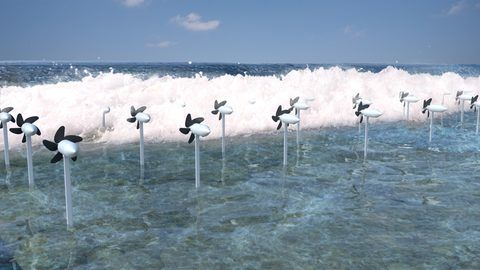Japan Develops Unique Wave-Catching Turbines to Harvest Power
Published on by Water Network Research, Official research team of The Water Network in Technology
Researchers with the Okinawa Institute of Science and Technology are solving two problems at one time by creating a unique wave turbine. The turbine both captures wave power and can help save shorelines from heavy wave erosion.

Coral reefs are another type of location with strong breaking waves.
Water moving from the deep sea over a shallow reef creates fast jet flows
of water. Arrays of small WECs will harness electricity from the vortex flow
of breaking waves. The design—dark-colored blades on top of white bodies
with thin stems—is visually pleasing, and resembles a flock of birds or group
of flowers. Image source: OIST
A team of researchers from the Okinawa Institute of Science and Technology just make a unique innovation that could revolutionize water power. The OIST developed a system that not only harnesses energy from crashing waves, it also dissipates the impact of the waves and could help save coastlines around the world.
Professor Tsumoru Shintake and the Quantum Wave Microscopy Unit at OIST started the "Sea Horse" project to try and take advantage of both wave power and reduce overall erosion along Japan's coast.
The project began with submerged turbines to convert the kinetic energy of the natural currents into electricity. That energy is delivered by cables to inland areas as well. Shintake noticed a considerable number of tetrapods along the coastline. Tetrapods are triangular structures that weaken the force of waves to protect a shore from erosion.
So, Shintake and his team decided to upgrade "Sea Horse" to take advantage of tetrapods. Shintake said that by putting turbines next to or attached to a tetrapod, the team would ultimately do more good.
"Using just 1 percent of the seashore of mainland Japan can [generate] about 10 gigawats [of energy], which is equivalent to 10 nuclear power plants," Shintake notedin a press release. "That's huge."
Thus, the Wave Energy Converter (WEC) project was born. Each turbine is positioned to experience the ideal wave conditions near coral reef systems or along preexisting tetrapods to generate energy. They're anchored to the sea with mooring cables. The turbines will 'peek' above the sea level at the proper height to catch most of the wave's energy. After more than three years of testing and trials, the team has finished the first step of the project. They're prepping for installation fo half-scale model turbines with a diameter of 0.35 meters for a commercial experiment.
Read full article: Interesting Engineering
Media
Taxonomy
- Technology
- Sustainability
- Energy Efficiency
- Wave & Tidal Energy
- Wave & Tidal Energy